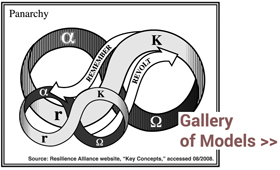Yesterday, I posted on a 1970s talk by Donella Meadows, above is a 1990s one. Speaking at the University of Michigan, Dana offered a tour de force introduction to system dynamics.
At the end, she was asked the classic question, Tolstoy’s question: “What is to be done?” I’m always interested in how people will respond to this challenge — perhaps because it’s a question I often ask myself.
Dana, as in her famous leverage points essay, pointed to the mindset or paradigm out of which the system arises. In this case, the system under discussion is the global socioeconomic system, and the dominant paradigm is the ideology of growth.
Q: I’ve come to every one of these lectures, and I always try to deduce: What should I change in my own life, on the basis of this lecture? What should I do differently when I go home tonight or tomorrow morning? What can I do to be more than just a random element in the system?
Dana: What a great question! And what a great way to attend this series! Congratulations. That’s wonderful.
I could tell you a lot of specific things, but I think I will end, and where I did end is: Be an irritant — to the mindset. Question growth. Question the “more.”
It doesn’t matter where you attack the mindset. It’s all around you. It’s in the grocery store. It’s in the schools. It’s in the home. It’s in your family. You are never out of shooting range if you want to shoot down the mindset of more, of growth.
So what I would say is: Just question it. Observe what comes back at you, and question it some more. Just start saying: Really, why do we need more? Really, how much is enough? Really, who needs more, of what?
There are people who need more. There are. It’s not that we should have no growth. It’s that we should stop worshiping growth and start getting smart about how much of it we can have and what it costs us. I’m sure Herman Daly told you: There are forms of growth that make you poorer, not richer. Start distinguishing them.
Just go around and question.
Dana’s talk begins at 6:15 on the first video, above; the piece I’ve transcribed is from the fourth video.

